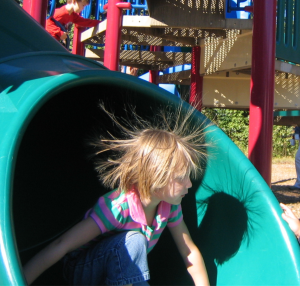I love pulling my laundry out of the drier right after it finishes its cycle because this is when the clothes have no wrinkles! But I have begun to notice an interesting phenomenon. When I try and pull out a piece of clothing, it usually wants to stick to the rest of the clothes in the dryer, and when I force this rebellious t-shirt out of the drier, it’s resistance is accompanied by crackling sounds and sometimes tiny little sparks.
A very similar phenomena occurs when you walk around the house in the winter with fuzzy socks on, only to receive a jolting shock when you touch a door handle. Or after touching your car door after getting into and out of your car or after sliding down a slide at a playground. So what in the world is happening when your clothes stick together or when your car or house door handle give you a shock? Or when your hair sticks up after sliding down a slide or rubbing it with a balloon? Most recognize this phenomena as static electricity. But what in the world is happening here and what does it have to do with chemistry?
The key is SUBATOMIC PARTICLES! Like we discussed earlier, there are three subatomic particles – protons, neutrons and electrons – that combine in various numbers and combinations to form every atom in the universe, and these atoms combine in various numbers and combinations to form every molecule in the universe, and ultimately every physical thing in the universe – and your clothes fall into this category!
When your clothes cycles around a drier, or when your pants rub across the car seat or down a slide at the playground, some of these subatomic particles will rub off! Since they have differing charges, they transfer this charge to their final location. This is called charging, and it’s when tiny charged particles rub off from one material and are left on another. The tiny particles which usually rub off are the electrons since they are so much smaller, lighter and mobile than the protons and neutrons.
When your clothes rub against each other in the drier, these tiny electrons will transfer from one piece of clothing to another. Since electrons have a negative charge, they cause their new home (your t-shirt) to become more negatively charged, where as their old home (your pajama pants) are now more positively charge since the negatively charged electrons have left them. Since your t-shirt and pajama pants are now oppositely charged, they attract each other!
The same thing happens to your body when you walk around the house with socks on, or slide down a slide at the park. You build up these tiny charges from all that rubbing! But why does the shock happen when you touch a door handle?
Think about the material of a door handle for a second. They are usually metal. And what is the difference between metals and a plastic slide, your socks, or pajama pants? The metal is conductive which means charges will easily flow through it, whereas the other items are what’s called insulators, materials in which charge remains immobile or does not move through it.
So this charge builds up on your body from all this rubbing, and has nowhere to go. When you touch a metal door handle, the conductive metal allows these charges to flow through it – this is the same thing as allowing electricity to flow through you, and Zap – you feel the shock!
This phenomena is even worse in the winter because the air is drier, whereas humid air (water) is more conductive and will continually cause the charges to release back to their original location instead of building up.
These tiny charges are the exact same charges that make up every atom in the universe, and thus every physical thing in the universe! In the next blog I’ll discuss more about how these crazy little charged particles make up the actual atoms!

